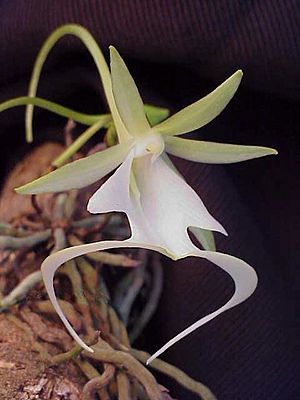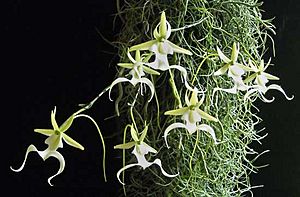Palm polly facts for kids
Quick facts for kids Ghost orchid |
|
|---|---|
 |
|
| Conservation status | |
| Scientific classification | |
| Genus: |
Dendrophylax
|
| Species: |
lindenii
|
| Synonyms | |
|
|
The Dendrophylax lindenii, often called the ghost orchid, is a special kind of orchid. It's a plant that grows on other plants, not in the soil. This amazing orchid is found in Florida and Cuba. People also call it the palm polly or white frog orchid.
Contents
What is a Ghost Orchid?
The ghost orchid is a type of epiphyte. This means it grows on trees but does not harm them. It gets its name "lindenii" from Jean Jules Linden. He was a plant collector from Belgium who first saw it in Cuba in 1844. Later, it was also found in the Everglades in Florida.
How Does it Grow?
Unlike most plants, the ghost orchid has almost no stem or leaves. Instead, it has a network of flat, green roots. These roots do most of the work, like making food. They have special white marks called pneumatodes. These marks help the plant breathe and take in gases.
The roots are covered in a spongy outer layer called velamen. This layer helps the orchid soak up water and nutrients from the air. It also lets light reach the green parts of the roots for photosynthesis. Photosynthesis is how plants use sunlight to make their own food.
Where Does it Live?
Ghost orchids love wet, swampy forests. In Florida, they often grow on pond-apple trees or pop ash trees. They usually attach themselves to the main trunk or big branches. You might find them at eye-level or a bit higher up.
Why is the Ghost Orchid Special?
This orchid is very unique because its roots blend in so well with the tree. When it blooms, the white flower looks like it's floating in the air. This is why it's called the "ghost orchid."
When Does it Bloom?
Ghost orchids usually bloom between June and August. They can produce one to ten flowers at a time. Each flower is white and quite large, about 3–4 cm wide and 7–9 cm long. They grow on spikes that come out from the root network.
The flowers smell strongest in the early morning. Their scent is fruity, a bit like an apple. The lower petal of the flower has two long, twisting parts. These look a bit like the hind legs of a jumping frog.
How Does it Reproduce?
For a long time, scientists thought only one type of giant moth pollinated the ghost orchid. But new research shows that the fig sphinx moth can also do the job. This means many other types of hawkmoths might help pollinate them too. Pollination is when pollen is moved from one flower to another, helping the plant make seeds.
Can You Grow a Ghost Orchid?
Growing a ghost orchid outside of its natural home is very hard. Most attempts to grow them from seeds fail. This orchid is an endangered species. It is protected by laws in Florida and by CITES (an international agreement). It is illegal to remove them from the wild. Plants taken from their natural habitat usually die within a year.
If you try to grow one, it needs a lot of humidity and still air. You should not let small plants make seeds. Making seeds uses up too much energy, and the plant might die. They also need special water without too many salts. If the water has too much chlorine, the roots can die.
Healthy ghost orchids have bright green root tips that are always growing. They need bright light, regular watering, and a little bit of fertilizer. They don't like freezing temperatures. To make them flower, you need to give them a cool, dry rest period in late fall and early winter.
Ghost Orchids in Stories
The ghost orchid is famous from the non-fiction book The Orchid Thief by Susan Orlean. This book was also made into a movie called Adaptation. The ghost orchid at the Blair Audubon Corkscrew Swamp Sanctuary also inspired a novel called Ghost Orchid by D. K. Christi. You can even find it as a collectible flower in the video game Red Dead Redemption 2.
See also
 In Spanish: Orquídea Fantasma para niños
In Spanish: Orquídea Fantasma para niños




